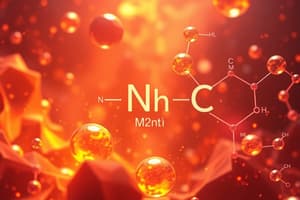Podcast
Questions and Answers
What type of ion is formed when an atom loses electrons?
What type of ion is formed when an atom loses electrons?
Alkali metals have a charge of -1.
Alkali metals have a charge of -1.
What is the charge of chlorine in ionic compounds?
What is the charge of chlorine in ionic compounds?
Magnesium loses two electrons to become a _____ ion.
Magnesium loses two electrons to become a _____ ion.
Match the following elements with their ionic charges:
Match the following elements with their ionic charges:
Using the crossover rule, what is the formula for aluminum and fluorine?
Using the crossover rule, what is the formula for aluminum and fluorine?
Ionic compounds are written with the nonmetal first followed by the metal.
Ionic compounds are written with the nonmetal first followed by the metal.
What is a key step in applying the crossover rule?
What is a key step in applying the crossover rule?
The _____ gas group has a charge of 0.
The _____ gas group has a charge of 0.
Flashcards
What is ionic stability?
What is ionic stability?
How does magnesium become an ion?
How does magnesium become an ion?
How does nitrogen become an ion?
How does nitrogen become an ion?
What is the ionic charge of alkali metals?
What is the ionic charge of alkali metals?
What is the ionic charge of alkaline earth metals?
What is the ionic charge of alkaline earth metals?
What is the ionic charge of inner gas elements?
What is the ionic charge of inner gas elements?
What is the ionic charge of halogens?
What is the ionic charge of halogens?
How does ionic charge change across a period?
How does ionic charge change across a period?
What is the crossover rule?
What is the crossover rule?
How do we use the crossover rule to find ionic compound formulas?
How do we use the crossover rule to find ionic compound formulas?
Ionic Stability
Ionic Stability
Cations
Cations
Anions
Anions
Alkali Metals
Alkali Metals
Alkaline Earth Metals
Alkaline Earth Metals
Halogens
Halogens
Noble Gases
Noble Gases
Crossover Rule
Crossover Rule
Ionic Compound
Ionic Compound
Study Notes
Ionic Charges
- Atoms achieve stability when their valence electron shell is full.
- Atoms with valence electrons lose or gain electrons to achieve a stable configuration.
- Magnesium (Mg), with two valence electrons, loses them to become a +2 cation.
- Cations are positively charged ions.
- Nitrogen (N), with five valence electrons, gains three electrons to become a -3 anion.
- Anions are negatively charged ions.
Shortcut Rules for Ionic Charges
- Alkali metals (Group 1) have a charge of +1.
- Alkaline earth metals (Group 2) have a charge of +2.
- Halogens (Group 17) have a charge of -1.
- Inner gases (Group 18) have a charge of 0 due to their full valence shells.
- For ionic charges, use the periodic table.
The Crossover Rule for Writing Formulas
- The crossover rule simplifies determining ionic compound formulas.
- Write the element symbols.
- Transfer the absolute values of the ionic charges as subscripts.
- Simplify the ratio of subscripts to the lowest whole numbers.
Examples
- Sodium (Na) + Chlorine (Cl): Na (+1) and Cl (-1) yield NaCl.
- Aluminum (Al) + Fluorine (F): Al (+3) and F (-1) yield AlF3.
- Magnesium (Mg) + Nitrogen (N): Mg (+2) and N (-3) yield Mg3N2.
Important Considerations
- Always simplify the ion ratio to the lowest whole number.
- Ionic compounds are written with the metal first, then the nonmetal.
- Lewis dot structures can verify the formula.
Studying That Suits You
Use AI to generate personalized quizzes and flashcards to suit your learning preferences.




